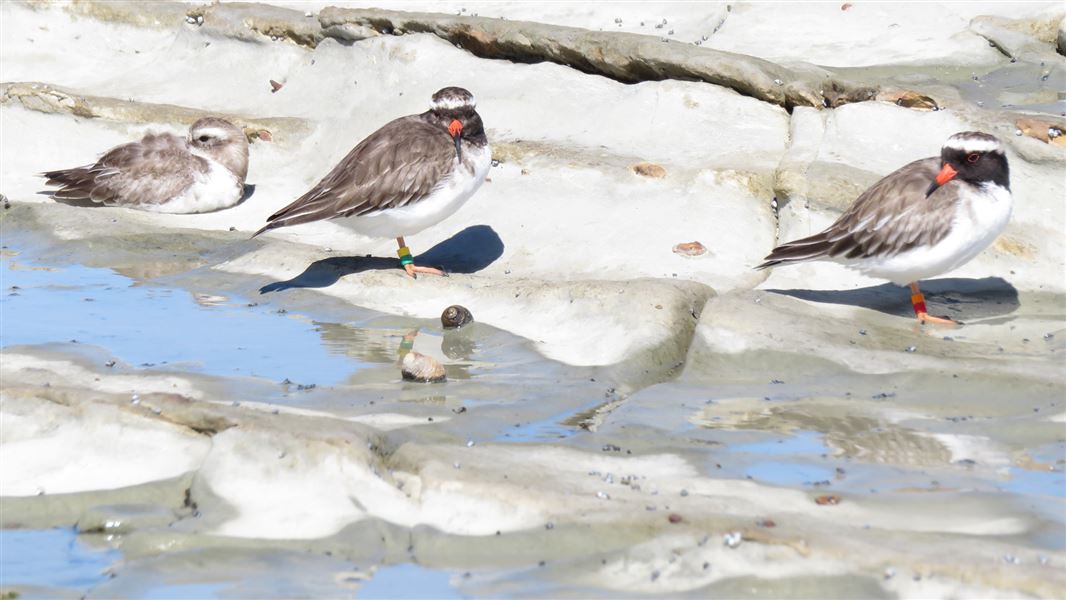New Zealand status: Endemic
Conservation status: Threatened–Nationally Critical
Found in: Beaches and wave platforms on predator-free islands
Threats: Predation, human disturbance
Species information: Shore plover on NZ Birds Online
Description
Tūturuatu are small shorebirds endemic to New Zealand, also known as tchūriwat’ by Moriori. There are only 250 birds, found in the Chatham Islands and a few predator-free islands around mainland New Zealand.
Tūturuatu have distinctive dark caps on their heads, bright red beaks and legs, and make a full-body bobbing motion. Their natural curiosity and territorial behaviour during breeding season, combined with their small size (60 grams), makes them highly susceptible to introduced predators like rats, stoats and cats.
Location
The former range of tūturuatu is poorly known. The first recorded sightings of the birds by Europeans were in Dusky and Queen Charlotte Sounds on Cook’s second voyage, and at river mouths in Otago by early settlers. They were also reported on mudflats and sandspits around the North Island, however this may have been a case of mistaken identity.
By the 1870s, introduced predators like cats and Norway rats caused tūturuatu to vanish from mainland coasts.
For more than 100 years, Rangatira/Hokorereoro in the Chatham Islands had the only known population of around 120 birds. More than half the current (2021) wild population of around 250 are in the Chatham Islands.
In the Chathams, they are also found on Mangere Island and are occasionally seen on Pitt Island. Around mainland New Zealand the largest population is on Waikawa/Portland Island in Hawke’s Bay. A small population exists on Motutapu Island in Auckland.
Predators
Introduced predators are the main reason for tūturuatu vanishing from New Zealand’s coastlines. Offshore islands are a refuge from stoats, cats and rats, however all sites are at risk of predator invasions.
Experience has shown that even a single rat can have a major impact.
Attempts to establish populations on Waikawa Island in 2012 and on Mana Island in 2007 have been hampered by rat incursions resulting in the loss of more than 80% of the resident birds. It was suspected that a single rat was the cause in both cases.
Recovery plan
DOC published the New Zealand Shore Plover Recovery Plan in 2001. The plan is under review.
The goal is to maintain and/or establish wild tūturuatu at five or more locations with a combined population of 250 or more mature individuals. Having multiple self-sustaining populations means that if something happens at one site, there will still be other secure populations.
Achieving this requires island biosecurity, captive breeding, and translocations to predator-free islands.
One of the biggest challenges facing tūturuatu is finding release sites for new breeding populations. As tūturuatu are so vulnerable to predation and have specific habitat needs, finding locations that meet the criteria is difficult.
A second attempt to establish a population on Mana Island was made in 2020 but was again unsuccessful, this time due to avian predation and birds dispersing to the mainland.
The Tūturuatu/Shore Plover Recovery Group are continuing to investigate potential release sites.
Captive management
Since the 1990s, Pūkaha National Wildlife Centre in Wairarapa and The Isaac Conservation and Wildlife Trust in Christchurch have carried out captive breeding of tūturuatu. Cape Sanctuary in Hawke’s Bay joined the programme in 2018.
Captive-reared juveniles have been released on predator-free islands and enabled the population on Waikawa to be established and are being used to attempt to establish a self-sustaining population on Motutapu.
You can help
Report sightings in Auckland and Hawke's Bay
Colour-banded tūturuatu were released on Motutapu Island and are often seen in the wider Auckland area. Tūturuatu also occasionally disperse from Waikawa Island and are seen around Hawke’s Bay.
Contact the Maungauika / North Head Office +64 9 445 9142 or Wairoa Base +64 6 838 8252.
Donate
Through the NZ Nature Fund, you can help by donating to the Shore Plover Recovery Programme. The NZ Nature Fund is supporting the DOC project to release juveniles on Motutapu Island in the Hauraki Gulf.
